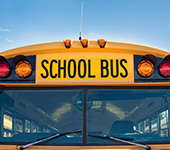
Schools are in a unique situation when it comes to disaster recovery. They are often limited to one physical location, so they are in trouble when disaster strikes.
Unlike corporations or higher education institutions, K-12 schools don’t have access to geographically dispersed branch offices or campuses. If a school loses its building due to a flood or fire, students’ education is put on hold.
A business may lose productivity and revenue after a disaster; but when a school shuts down, students are losing out on a priceless resource: their education.
Moving to the cloud helps schools protect their data so they can bounce back after a disaster. Cloud-based disaster recovery allows schools to back up and restore information off-site without needing a second physical location.
Losing Educational Ground
 Last year’s Hurricane Harvey caused major damage to 53 Houston-area schools, requiring the most severely damaged of them to be closed for months. After a natural disaster, students need to be able to continue with their education as soon as possible.
Last year’s Hurricane Harvey caused major damage to 53 Houston-area schools, requiring the most severely damaged of them to be closed for months. After a natural disaster, students need to be able to continue with their education as soon as possible.
Most districts require that the school year lasts for a certain number of days, and only a few days off are included in the schedule for weather-related closings.
When a disaster forces a school to close down for more than a few days, students begin falling behind on the curriculum. After an extended closure, students may begin to forget what they’ve already learned and may not be equipped to move to the next grade level. They may also miss out on preparation for scheduled standardized tests.
School Records at Risk
Schools need to be able to preserve students’ academic, attendance, and discipline records (though some students might like to see a sentence of detention erased from their permanent record). Administrators use these records to promote students to the next grade. Students will eventually need them to apply for college or secure employment.
Today, most school records are digital, which means that they could be lost if administrators’ computers are damaged. School computers are also vulnerable to ransomware that encrypts student files and erases on-site backup files.
Without backups, cash-strapped school districts are forced to pay huge ransoms ― which many can’t afford ― in order to get their records back. In April 2018, Leominster Public Schools was forced to pay the equivalent of $10,000 in bitcoin after it was attacked by ransomware. The school district received backlash from the community for caving in. Administrators, however, felt that they had no other option, since the district lacked off-site backup for its records.
Disaster Recovery on a Tight Budget
 Most schools don’t have the funding to pay for a top-notch disaster recovery solution. Many struggle just to pay for the basics, such as school supplies and maintenance of heating and cooling systems. This is especially true for public schools, which rely on government funding.
Most schools don’t have the funding to pay for a top-notch disaster recovery solution. Many struggle just to pay for the basics, such as school supplies and maintenance of heating and cooling systems. This is especially true for public schools, which rely on government funding.
Cloud-based disaster recovery allows schools to have access to enterprise-level data protection at an affordable rate. With disaster recovery as a service (DRaaS), schools can forgo paying for a secondary data center to use for backup and recovery.
Instead, schools can subscribe to cloud resources at a monthly rate. The Federal Communications Commission (FCC) sponsors an E-Rate program that subsidizes the internet resources needed to support cloud-based disaster recovery.
Protecting Our Children’s Future
Schools shouldn’t be left vulnerable to natural disasters, equipment failures, or major breaches. Too much is at stake when education is put at risk. Parents, students, and teachers should feel confident that learning can continue uninterrupted after a traumatic incident and that student information will remain intact.
The cloud provides an affordable way to protect student data. After a disaster, systems instantly fail over to the cloud, preserving student information and allowing for uninterrupted access to learning resources.
FirstLight has experience providing K-12 educational institutions in the New England Region with cloud, telecommunications, and internet. Our DRaaS offering is supported by our extensive high-speed fiber optic network.
We make cloud disaster recovery affordable for K-12 educators by supporting it with internet services funded through the E-Rate Program. The E-Rate Program is dedicated to making educational technology more accessible to students.
Don’t let your school go another day without data protection. Contact FirstLight today.






















